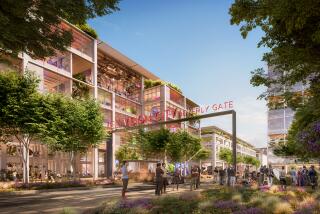Bustling Downtown Arises From Failed Mall
- Share via
After years of playing second fiddle to Westwood as a nighttime entertainment center, downtown Santa Monica is about to become the latest spot where multiplexes collide.
If all goes according to plan, by next summer a renovated outdoor mall in the city-by-the-sea will be home to first-run movie palaces operated by three of the biggest companies in the multiscreen business: American Multi-Cinema, Cineplex Odeon and Mann Theatres. They will have as their neighbors a branch of the famed Improv comedy club, a spinoff of the legendary Second City comedy troupe and, if projects now in negotiation go through, an art/foreign movie theater and a couple of cabaret jazz clubs.
“What we are saying to people here is that they don’t have to drive to Westwood or anywhere else for a night out,” Santa Monica City Councilman Dennis Zane said. “Bringing in entertainment in a careful way will energize our whole downtown area.”
That’s a common sentiment in city planning, but in Santa Monica the anticipated projects have come through with great speed. Except for the art/foreign movie theater, which is planned as part of a residential project, the developers of these movie theater ventures hope to be in business within a year.
This explosion of activity is all the more surprising because Santa Monica has little in the way of a track record for these venues, especially downtown. There are only two downtown movie theaters--one shows specialty and second-run films and the other features X-rated movies.
What makes downtown Santa Monica the new promised land?
The entire city has become a highly desirable residential and commercial location in the past few years and the city government has demonstrated a willingness to ease the way for downtown commercial attractions it deems desireable.
But the entertainment boom would likely have never come about if it weren’t for a mid-1960s retail experiment that failed.
The Santa Monica Mall was established in 1964 when the city blocked motor traffic for a 3-block commercial area, along Third Street between Wilshire Boulevard and Broadway. The result was a wide outdoor mall made to order for strolling shoppers.
“Lots of cities blocked streets and built these kind of malls in the ‘50s and ‘60s,” said Tom Carroll, executive director of the Bayside District Corp., which is overseeing the downtown redevelopment. “It was a trend that came out of architects looking towards Europe where there have long been walking malls in downtown areas,”
Like many of the pedestrian malls that were built across the nation, the Santa Monica development fell into decline after only a few years.
“These malls worked in Europe because there was a long tradition of residential living downtown, of big apartment buildings along with the commercial stores,” Carroll said. “They gave the malls a vitality that the new developments in this country never could have. By cutting off traffic, all we did here was cut off access to an area with little of its own life.
“All it created was a dead zone.”
The dead zone in Santa Monica got deader in the mid-1970s with the development of the adjacent Santa Monica Place indoor mall project. While the new, Frank Gehry-designed Place attracted upscale department stores and national outlets, the outdoor mall had only one nationally known chain store--J.C. Penney. The walking mall was mostly populated by mom and pop stores, fast-food shops and discount emporiums. Turnover was heavy.
A decade later, with Santa Monica becoming one of the most desirable living spots in the Los Angeles area, the Chamber of Commerce urged the city to do something to boost the fortunes of Santa Monica Mall. In 1984, the City Council formed a nonprofit, public benefit corporation charged with formulating a plan for the mall and then administering it.
The biggest problem the corporation faced was attracting revenue-generating entities without putting the outdoor mall into direct competition with Santa Monica Place. The main focus could not be on retail.
Movie multiplexes were suggested early on as an alternative, but the major exhibitors were not interested. “They told us they already had first-run ‘zones’ in Westwood and the Marina, and that we were too close to them to make us one too,” Carroll said.
The emphasis shifted to outdoor dining, augmented in cool weather by gas heaters. The corporation hoped that a variety of restaurants, with a wide range of dining fare and prices, would give new life to the area and attract office building developers.
Plans were drawn up to renovate the area. In the version that was eventually approved, the sidewalks were kept wide enough to allow outdoor dining, while traffic lanes in each direction were re-established so cars could move slowly through the area. (The roadway was designed to be closed off easily when foot traffic is especially heavy).
In addition, the plan called for 300 parking spaces to be added to the 2,700 in existing city structures near the mall.
A $13-million bond issue was created to pay for the program--$6 million for the public space and roadway renovations, $4 million for new parking spaces and $3 million to retire a past bond issue.
And two years after the corporation was formed, the movie exhibitors suddenly started calling.
“I woke up one morning and there were cinema projects trying to establish a foothold all over the city,” Zane said. “It seemed as if they all discovered us overnight.”
“You didn’t have to be a rocket scientist to see that Santa Monica was a good place to be,” said Greg Rutowski, a vice president of AMC, based in Kansas City, Mo. “We looked around at our success with our Century City location and the success others were also having on that side of town. We realized there was a good market out there and a demographic range that allowed for the showing of everything from action to the more sophisticated films.”
Why did exhibitors pounce on Santa Monica at the same time?
“There are very few secrets in exhibition,” Rutowski said. “Everyone is looking at the same statistics and looking for the next hot market place.”
Cineplex Odeon was the first on the scene. The Toronto-based company got in touch with Carroll in 1986 and he introduced them to William Janss, a fourth-generation Southern California developer. The Janss family was the original developer of Westwood Village in the 1920s (the family donated the land for the UCLA campus), and was instrumental in the development of Thousand Oaks and other areas.
“We viewed downtown as a transition area,” Janss said. “To the north you have Montana Avenue and to the south is Main Street in Ocean Park, both of which are doing very well as commercial developments. And then there is this void in the middle.”
Janss, with Marvin Davis as his financial partner, began in mid-1986 to develop what has turned into the $24-million Janss Court, a primarily office/residential complex now under construction at Third and Broadway. The bottom floor of the court will include a sit-down and take-out delicatessen operated by Bruce Marder (of West Beach Cafe and Rebecca’s) and Marvin Zeidler and Michael Richard (of Citrus).
Cineplex took out a long-term lease to install a 4-screen, 1,100-seat multiplex on the site of the Cine Latino, a movie theater that was closed in 1987 and purchased to be a part of the Janss Court project. Cineplex aims to open it theaters in June.
AMC originally planned on being a part of a commercial complex that was going to be built on the site of a bowling alley on Pico Boulevard, several streets south of the renovated mall. But when the City Council got wind of the plans, it moved quickly to discourage the project.
“We knew there would be numerous neighborhood problems if a movie theater tried to move in adjacent to a residential area,” Zane said, citing the strong opposition to some of the developments on Main Street.
“The beauty of the new mall project is that it is far away from any residential neighborhoods,” Zane said. “It makes it a much stronger candidate for this kind of development.”
The council moved to rezone the Pico Boulevard site and pass ordinances that made it difficult for entertainment complexes to be built outside the new mall.
AMC will build a 7-screen, 2,200-seat multiplex on site of the former J.J. Newberry’s five-and-dime store at Arizona Avenue and Third Street for a projected opening next summer. Rutowski said AMC will spend approximately $5 million to build the facility and $1 million for furniture and fixtures.
The Mann complex will be built between Arizona Avenue and Santa Monica Boulevard on the site of the Criterion movie theater, which closed in 1984. Officials of the Los Angeles-based exhibitor said they would not discuss their plans for their proposed 6-screen, 1,600-seat multiplex until they were approved by the state Coastal Commission. AMC and Cineplex Odeon have already received the necessary construction approvals.
Still under negotiation with the city is a fourth movie project for the mall, a 2-screen facility that would be part of a city-sponsored housing project. It would mark a rebirth of the Fox International, which formerly showed foreign, political and art films in a venerable theater in Venice.
The city asked Rafigh Pooya, who operated the Venice theater until it was closed down because of asbestos, to draw up plans for the proposed theater, which it would build.
“Because we were losing the Cine Latino on the mall,” Zane said, “we felt there should still be a place for Spanish language films.”
Pooya, who would rent the space, would be under no contractual obligation to show Spanish language films, but said he would regularly program them.
“I gave my word on it,” Pooya said. “It makes sense, economically, to show quality films for the Hispanic community and everyone interested in good film. Especially because I will have two screens to work with. If the demand to see these films is not there right away, we would work hard to create the demand. We are used to taking an aggressive approach to making people aware of films that are not always considered commercial.”
Pooya said that most optimistic opening date for the new Fox would be a year from now.
However all these projects fare, the outdoor mall will surely be forever changed. By next August when the renovations are completed on the mall, which is being renamed the Santa Monica Promenade, rents will likely take a sharp turn upward in reaction to soaring building prices. Muselli Commercial Realtors, a firm that has handled several building sales on the mall, recently completed a study of transactions they handled there. It shows a jump in the average price per square foot from $59.52 in 1984 to $122.83 this year.
Already, many of the discount and mom and pop stores have closed down or moved and more will probably follow as leases expire.
Some of these stores were gathering places for senior citizens who came to Santa Monica to retire in the beach community before the area’s economic boom. Carroll said he hopes seniors will still gather on the mall and attend city-sponsored outdoor concerts and other events there. He said there has been talk of establishing a mall branch of Emeritus College, a program of Santa Monica College that offers courses to seniors.
There are no special programs being established for another group that has given the mall heavy use--Santa Monica’s homeless population, which is attracted by the area’s seaside parks. Carroll says, however, that the corporation has hired, for special projects, clients of Step Up On Second, a local mental health agency that works with the homeless.
Although undeniably excited by the project, Zane and Carroll were eager to point out that controls have been put in place--including an overall limit of 4,500 theater seats to keep the development from becoming so successful that it becomes a “Westwood-by-the-sea,” a term used in the corporation’s promotion magazine.
Too much success could mean, in the words of the magazine, “overcrowding, insufficient parking facilities and overzealous high-rise development.”
“We don’t want to be another Westwood,” Zane said. “I can’t think of anyone who enjoys going to the movies there anymore.
“It is not our intention to create a yuppie development. They are welcome, but they are not the only people in the community. We want this area to be a community center that serves the broad diversity of people here.
“We do want success, of course, but it’s not the end-all. What we want is a project that is hardheaded, financially, but that doesn’t mean it can’t also have a soft heart.”
More to Read
Inside the business of entertainment
The Wide Shot brings you news, analysis and insights on everything from streaming wars to production — and what it all means for the future.
You may occasionally receive promotional content from the Los Angeles Times.











